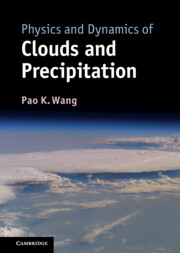Book contents
- Frontmatter
- Contents
- Preface
- 1 Observation of clouds
- 2 The shape and size of cloud and precipitation particles
- 3 Molecular structures of water substance
- 4 Bulk thermodynamic equilibrium among water vapor, liquid water, and ice
- 5 Surface thermodynamics of water substance
- 6 Aerosol in the atmosphere
- 7 Nucleation
- 8 Hydrodynamics of cloud and precipitation particles
- 9 Diffusion growth and evaporation of cloud and precipitation particles
- 10 Collision, coalescence, breakup, and melting
- 11 Cloud drop population dynamics in the warm rain process
- 12 Fundamental cloud dynamics
- 13 Numerical cloud models
- 14 Cloud electricity
- 15 Clouds–environment interaction
- References
- Index
- Plate section
4 - Bulk thermodynamic equilibrium among water vapor, liquid water, and ice
Published online by Cambridge University Press: 05 March 2013
- Frontmatter
- Contents
- Preface
- 1 Observation of clouds
- 2 The shape and size of cloud and precipitation particles
- 3 Molecular structures of water substance
- 4 Bulk thermodynamic equilibrium among water vapor, liquid water, and ice
- 5 Surface thermodynamics of water substance
- 6 Aerosol in the atmosphere
- 7 Nucleation
- 8 Hydrodynamics of cloud and precipitation particles
- 9 Diffusion growth and evaporation of cloud and precipitation particles
- 10 Collision, coalescence, breakup, and melting
- 11 Cloud drop population dynamics in the warm rain process
- 12 Fundamental cloud dynamics
- 13 Numerical cloud models
- 14 Cloud electricity
- 15 Clouds–environment interaction
- References
- Index
- Plate section
Summary
All three phases of water – vapor, liquid, and solid – are present in atmospheric clouds. As a cloud evolves, the relative proportions of water in the different phases within it will change in response to the changing cloud environment. The environment, in turn, will be changed in response to the changes in water substance. Thus the water substance in a cloud and the cloud environment are not independent of each other but are “coupled” – changes in one will lead to changes in the other. They may influence each other in many ways, but one of the most important pathways of such influences is via thermodynamics.
In this chapter, we will discuss in some detail the thermodynamic equilibrium of water of different phases: how different phases of water can turn into each other and, when this happens, what changes may result in the cloud. We will discuss the thermodynamic equilibrium not only of pure water but also of aqueous solutions, as the latter play a very important role in cloud formation.
Thermodynamic systems
Let us begin by reviewing the simple definitions of a few thermodynamic terms:
System A thermodynamic system is a specific part of the universe that is separated from the rest of the universe by boundaries. The “rest of the universe” will be called the environment of this system.
- Type
- Chapter
- Information
- Physics and Dynamics of Clouds and Precipitation , pp. 86 - 106Publisher: Cambridge University PressPrint publication year: 2013



